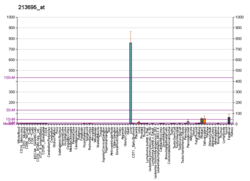PON3
Paraoxonase 3, also known as PON3, is a protein which in humans is encoded by the PON3 gene.[5][6]
Function
This gene is a member of the paraoxonase family and lies in a cluster on chromosome 7 with the other two family members. The encoded protein is secreted into the bloodstream and associates with high-density lipoprotein (HDL). The protein also rapidly hydrolyzes lactones and can inhibit the oxidation of low-density lipoprotein (LDL), a function that is believed to slow the initiation and progression of atherosclerosis. Alternatively spliced variants which encode different protein isoforms have been described; however, only one has been fully characterized.[6]
References
- 1 2 3 GRCh38: Ensembl release 89: ENSG00000105852 - Ensembl, May 2017
- 1 2 3 GRCm38: Ensembl release 89: ENSMUSG00000029759 - Ensembl, May 2017
- ↑ "Human PubMed Reference:".
- ↑ "Mouse PubMed Reference:".
- ↑ Primo-Parmo SL, Sorenson RC, Teiber J, La Du BN (May 1996). "The human serum paraoxonase/arylesterase gene (PON1) is one member of a multigene family". Genomics. 33 (3): 498–507. doi:10.1006/geno.1996.0225. PMID 8661009.
- 1 2 "Entrez Gene: PON3 paraoxonase 3".
Further reading
- Mackness B, Durrington PN, Mackness MI (2003). "The paraoxonase gene family and coronary heart disease". Curr. Opin. Lipidol. 13 (4): 357–62. doi:10.1097/00041433-200208000-00002. PMID 12151850.
- Ng CJ, Shih DM, Hama SY, et al. (2005). "The paraoxonase gene family and atherosclerosis". Free Radic. Biol. Med. 38 (2): 153–63. doi:10.1016/j.freeradbiomed.2004.09.035. PMID 15607899.
- Primo-Parmo SL, Sorenson RC, Teiber J, La Du BN (1996). "The human serum paraoxonase/arylesterase gene (PON1) is one member of a multigene family". Genomics. 33 (3): 498–507. doi:10.1006/geno.1996.0225. PMID 8661009.
- La Du BN (2001). "Is paraoxonase-3 another hdl-associated protein protective against atherosclerosis?". Arterioscler. Thromb. Vasc. Biol. 21 (4): 467–8. doi:10.1161/01.ATV.21.4.467. PMID 11304457.
- Reddy ST, Wadleigh DJ, Grijalva V, et al. (2001). "Human paraoxonase-3 is an HDL-associated enzyme with biological activity similar to paraoxonase-1 protein but is not regulated by oxidized lipids". Arterioscler. Thromb. Vasc. Biol. 21 (4): 542–7. doi:10.1161/01.ATV.21.4.542. PMID 11304470.
- Xu XR, Huang J, Xu ZG, et al. (2002). "Insight into hepatocellular carcinogenesis at transcriptome level by comparing gene expression profiles of hepatocellular carcinoma with those of corresponding noncancerous liver". Proc. Natl. Acad. Sci. U.S.A. 98 (26): 15089–94. doi:10.1073/pnas.241522398. PMC 64988. PMID 11752456.
- Strausberg RL, Feingold EA, Grouse LH, et al. (2003). "Generation and initial analysis of more than 15,000 full-length human and mouse cDNA sequences". Proc. Natl. Acad. Sci. U.S.A. 99 (26): 16899–903. doi:10.1073/pnas.242603899. PMC 139241. PMID 12477932.
- Scherer SW, Cheung J, MacDonald JR, et al. (2003). "Human chromosome 7: DNA sequence and biology". Science. 300 (5620): 767–72. doi:10.1126/science.1083423. PMC 2882961. PMID 12690205.
- Hillier LW, Fulton RS, Fulton LA, et al. (2003). "The DNA sequence of human chromosome 7". Nature. 424 (6945): 157–64. doi:10.1038/nature01782. PMID 12853948.
- Aharoni A, Gaidukov L, Yagur S, et al. (2004). "Directed evolution of mammalian paraoxonases PON1 and PON3 for bacterial expression and catalytic specialization". Proc. Natl. Acad. Sci. U.S.A. 101 (2): 482–7. doi:10.1073/pnas.2536901100. PMC 327173. PMID 14695884.
- Ota T, Suzuki Y, Nishikawa T, et al. (2004). "Complete sequencing and characterization of 21,243 full-length human cDNAs". Nat. Genet. 36 (1): 40–5. doi:10.1038/ng1285. PMID 14702039.
- Jin P, Fu GK, Wilson AD, et al. (2004). "PCR isolation and cloning of novel splice variant mRNAs from known drug target genes". Genomics. 83 (4): 566–71. doi:10.1016/j.ygeno.2003.09.023. PMID 15028279.
- Gerhard DS, Wagner L, Feingold EA, et al. (2004). "The status, quality, and expansion of the NIH full-length cDNA project: the Mammalian Gene Collection (MGC)". Genome Res. 14 (10B): 2121–7. doi:10.1101/gr.2596504. PMC 528928. PMID 15489334.
- Draganov DI, Teiber JF, Speelman A, et al. (2005). "Human paraoxonases (PON1, PON2, and PON3) are lactonases with overlapping and distinct substrate specificities". J. Lipid Res. 46 (6): 1239–47. doi:10.1194/jlr.M400511-JLR200. PMID 15772423.
- Shamir R, Hartman C, Karry R, et al. (2005). "Paraoxonases (PONs) 1, 2, and 3 are expressed in human and mouse gastrointestinal tract and in Caco-2 cell line: selective secretion of PON1 and PON2". Free Radic. Biol. Med. 39 (3): 336–44. doi:10.1016/j.freeradbiomed.2005.03.016. PMID 15993332.
- Lu H, Zhu J, Zang Y, et al. (2005). "Cloning, high level expression of human paraoxonase-3 in Sf9 cells and pharmacological characterization of its product". Biochem. Pharmacol. 70 (7): 1019–25. doi:10.1016/j.bcp.2005.07.004. PMID 16099434.
- Lu H, Zhu J, Zang Y, et al. (2006). "Cloning, purification, and refolding of human paraoxonase-3 expressed in Escherichia coli and its characterization". Protein Expr. Purif. 46 (1): 92–9. doi:10.1016/j.pep.2005.07.021. PMID 16139510.
- Liu T, Qian WJ, Gritsenko MA, et al. (2006). "Human plasma N-glycoproteome analysis by immunoaffinity subtraction, hydrazide chemistry, and mass spectrometry". J. Proteome Res. 4 (6): 2070–80. doi:10.1021/pr0502065. PMC 1850943. PMID 16335952.
This article is issued from
Wikipedia.
The text is licensed under Creative Commons - Attribution - Sharealike.
Additional terms may apply for the media files.




